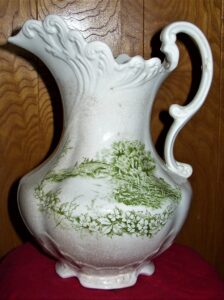 LD owns an ewer and basin she has known of for her 80 years. She writes about her parent’s life stories, and she asked me to piece together the ownership. She assumes the perfect shape of the ewer means SOMEONE must have loved it. The basin appears in poor condition.
LD owns an ewer and basin she has known of for her 80 years. She writes about her parent’s life stories, and she asked me to piece together the ownership. She assumes the perfect shape of the ewer means SOMEONE must have loved it. The basin appears in poor condition.
She calls the story of the ewer a mystery because it seems likely that, in the family tree she sent, a definite owner is not evident. A family member helped LD put a family genealogy together and sent me information on both sides of LD’s family. So which side owned this Ewer? Her father’s side was Sicilian and her mother’s German English. I solved this mystery for LD. The English side owned it!
But what fun along the way.
I read that someone in her family, Hans Devauld Van Der Berg (b. 1724 Solingen, Germany), led a charmed life. The grandson of Princess Elizabeth Ann of Berg (b 1680), whose son John and wife set sail to find his fortune in America with a huge family of ten. All but one member perished at sea off the Carolinas. A passing ship rescued 14 year-old Hans. They subsequently sold him as an indentured servant to a plantation owner in Orangeburg South Carolina, probably around 1740. Along the way someone rebranded him Hans Funderberg, because it sounds like Van Der Berg. He escaped his indentured servitude, left for Lancaster Country, South Carolina in the mid-18th century. No, the ewer didn’t belong to his, it’s too “new.”
Now the other branch of LD’s family
The English McKnight’s, came to Philadelphia in 1762, renamed the “Knight “ family, and sons of the family didn’t leave Pennsylvania till one of them married an Illinois gal. I bet this Ewer belonged to THAT family, and here’s why:
A faint name in the base of the Ewer reads: Lebeau Porcelain. That brand began in France in 1879, but the ‘middle class porcelain’ they made was not porcelain, but stoneware finished with a white glaze to resemble French porcelain. Thus, they didn’t sell it to the high brows. It became popular with the Americans, and a branch of the business opened in Sebring, OH in late 19th early 20th century. If LD’s ewer came imported from France, I’d find it stamped Lebeau “France.” By 1892 the McKinley Tariff Act specified imported wares stamped with country of origin. The style of the ewer appears late 19th early 20th century, around the time of the decree. LD’s Ewer, exhibits French pretensions, but in fact is made of America ceramic, not French porcelain at all.
Ewer Puzzle Solved
Middle class American families around that time took advantage of the ceramic ware made locally. The late 19th early 20th century was a time of specialized objects for specialized “wants/desires” of the middle class. Companies transported breakable ceramics by hand. American middle class families tended to purchase factory seconds from factories that sold close to home. LD’s Ewer came cheap and functional, used with the basin for washing oneself before indoor plumbing. This also indicates the economic level of the owner, who, if wealthy, had indoor plumbing by 1890.
Remember I said the branch of the Knight family did not leave Pennsylvania till around 1890? Specifically, that branch formerly homesteaded in Rogersville PA, two plus hours by train or one hour to Pittsburg, where I assume Lebeau factory outlet stores were located.
Thus, I date the acquisition of the Ewer to right before the Knight branch of the family moved to marry in Illinois, accomplished by William Thomas Knight (b 1859) who married Malina Elizabeth Nichols (b 1856) in Carlyle Illinois in around 1890.
Family objects tell a story about families always, even though today we want to divest ourselves of such telling objects. They still DO have a voice to those that listen. I hope LD finds my sleuthing good enough to have solved the mystery of WHY the Ewer was treasured. Probably brought as a souvenir of the Pennsylvania area to the Midwest by DP’s great grandparents, a reminder of a time before plumbing.
Pingback: Stoneware with a Salt Glaze - Elizabeth Appraisals